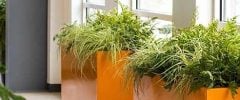When to Retire Plants in Client Accounts

After two decades in the interiorscape industry, I’ve found myself thinking more and more about retirement. I still enjoy working with plants and am very grateful to earn a living doing what I love. However, the older I get, the more I look forward to the day when the only plants I need to care for are my own. The physical demands of this business are really taking a toll on my body as I age. Similarly, plants also show signs of aging, but deciding when to retire an aging plant from a client’s account can be challenging.
It seems counterintuitive to replace a plant that isn’t dying, especially if your business guarantees plant replacements. At the same time, maintaining sub-par foliage can negatively reflect on your company’s quality of service. So, how do you decide the right time to retire a plant? Here are a few factors I consider before making that decision.
Foliage Age
Old age doesn’t necessarily warrant replacement. While the average lifespan of an indoor plant is 2-3 years, I have several plants that are two decades old. Take, for instance, an arborea tree in one of my best accounts. It’s at least twenty-five years old, if not older, and nearly reaches the office ceiling. Its trunk is thick with a unique curve, and its canopy of leaves is still full and vibrant green. Given that very few nurseries near me still grow arboreas, finding a comparable replacement would be nearly impossible. Retiring this tree would mean providing my client with a much smaller sapling, probably around four feet tall compared to the current eight. This could understandably leave them feeling shortchanged. In optimal conditions, plants with good genetics can increase in value over time—age alone is not a reason for replacement. However, foliage age is something that should generally be considered when determining whether to retire a plant.
Signs of Aging
Just as I’ve noticed dark brown spots showing up on my hands as I age, plants can also develop unsightly leaf discoloration. In Florida, where hard water is prevalent, yellow or pale spots often appear on leaves because of mineral content. Poor lighting and temperature fluctuations can also negatively affect foliage appearance. If these blemishes can be removed with scissors with a few angled cuts, or by removing a few affected leaves, then I’ll keep the plant in place. However, I usually retire it when trimming becomes a weekly necessity and multiple leaves have to be removed.
Support Requirements
The older a plant gets, the more likely its branches droop or its trunk leans, making it unstable. If these issues can’t be resolved by replacing eroded soil, and staking the trunk is the only solution, it might be time to consider retirement. The same goes for using floral wire to support heavy branches. Exposed mechanics, like stakes and wire, can signal poor service quality. However, there are a few exceptions, such as a rare plant or one that holds sentimental value for the client.
Take, for example, a gorgeous 8-foot Song of India tree in a client’s office that started off as a 4-foot bush. Instead of replacing it, I’ve discreetly secured a few branches with small pieces of bamboo, which blend seamlessly with the trunk. According to the client, this tree has significant emotional value and has seen him through years of challenges, along with success, and even if it had only a few leaves left, he would still cherish this plant for the simple fact that it’s been through “hell” with him.
This sentiment is common with many of my clients in high-stress industries like mortgage or banking. I’ve even referred to some of these plants as a “Charlie Brown tree.” Despite my suggestions to replace them, my clients’ attachment to these plants often leads me to maintain them. Sometimes the sentimental value far outweighs any aesthetic aspects, especially when the plant is not prominently displayed.
Thinning Foliage
Just as some people lose their hair, plants can suffer similar fates, particularly when their lighting conditions are less than ideal. Anytime a plant goes from a perfect greenhouse environment to the artificial light of a building, there’s going to be foliage loss as the plant acclimates. If this leaf drop continues for several months, it’s a sign the plant won’t adjust, and I mark it for replacement.
Consider ficus trees, which often struggle to maintain a full head of leaves. Yet, I have a Ficus benjamina in a third-floor office corner that has thrived for over twenty years. Despite not receiving direct sunlight, it sheds only a few leaves each year. Why some plants can survive the odds and remain attractive for over twenty years remains a mystery. Whether due to luck, genetics, or the perfect environment, they continue to flourish well beyond their expected prime.
Although deciding when to retire a plant might seem straightforward, it’s a crucial skill that ensures your plant displays remain vibrant and your business thrives. Tuning into the subtle cues of plant health and making timely decisions helps maintain the beauty of your interiorscape and secure the satisfaction of your clients.
You May Also Like
Leave a Reply
You must be logged in to post a comment.




















